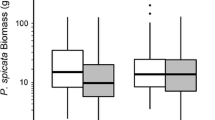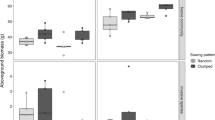Abstract
Invasive plant species can form dense populations across large tracts of land. Based on these observations of dominance, invaders are often described as competitively superior, despite little direct evidence of competitive interactions with natives. The few studies that have measured competitive interactions have tended to compare an invader to natives that are unlikely to be strong competitors because they are functionally different. In this study, we measured competitive interactions among an invasive grass and two Australian native grasses that are functionally similar and widely distributed. We conducted a pair-wise glasshouse experiment, where we manipulated both biotic factors (timing of establishment, neighbour identity and density) and abiotic factors (nutrients and timing of water supply). We found that the invader significantly suppressed the performance of the natives; but its suppression ability was contingent on resource levels, with pulsed water/low nutrients or continuous watering reducing its competitive effects. The native grasses were able to suppress the performance of the invader when given a 3-week head-start, suggesting the invader may be incapable of establishing unless it emerges first, including in its own understorey. These findings provide insight for restoration, as the competitive effect of a functionally similar invader may be reduced by altering abiotic and biotic conditions in favour of natives.




Similar content being viewed by others
References
Aarssen LW, Epp GA (1990) Neighbour manipulations in natural vegetation: a review. J Veg Sci 1:13–20
Abrams P (1983) The theory of limiting similarity. Annu Rev Ecol Syst 14:359–376
Anderson E (2003) Plants of Central Queensland, their identification and uses. Queensland Department of Primary Industries, Brisbane
Badgery W, Kemp D, Michalk D, King W (2005) Competition for nitrogen between Australian native grass and the introduced weed Nassella trichotoma. Ann Bot 96:799–809
Bayer AW (1955) The Ecology of grasslands. In: Meredith D (ed) The grasses and pastures of South Africa. Cape Times Press, Capetown, pp 539–571
Bazzaz FA (1996) Plants in changing environments: linking physiological, population, and community ecology. Cambridge University Press, Cambridge
Biggs A, Coutts A, Harris PS (eds) (1999) Central Darling Downs land management manual. Queensland Department of Primary Industries, Brisbane
Buckley YM, Briese DT, Rees M (2003) Demography and management of the invasive plant species Hypericum perforatum. I. Using multi-level mixed-effects models for characterizing growth, survival and fecundity in a long-term data set. J Appl Ecol 40:481–493
Campbell MH (1983) Area, distribution and weed potential of Eragrostis curvula (Schrad.) Nees in New South Wales. Aust Weeds 2:107–112
Chapin FS III, Torn MS, Tateno M (1996) Principles of ecosystem sustainability. Am Nat 148:1016–1037
Chesson P (2000) Mechanisms of maintenance of species diversity. Annu Rev Ecol Syst 31:343–366
Chesson P, Kuang JJ (2008) The interaction between predation and competition. Nature 456:235–238
Cousens R (2000) Greenhouse studies of interactions between plants: the flaws are in interpretation rather than design. J Ecol 88:352–353
Crawley MJ (2002) Statistical computing, an introduction to data analysis using S-Plus. Wiley, West Sussex
Davis MA, Grime JP, Thompson K (2000) Fluctuating resources in plant communities: a general theory of invasibility. J Ecol 88:528–534
Dukes JS (2001) Biodiversity and invasibility in grassland microcosms. J Ecol 126:563–568
Dwyer G, Morris W (2006) Resource-dependent dispersal and the speed of biological invasions. Am Nat 167:165–176
Emery SM (2007) Limiting similarity between invaders and dominant species in herbaceous plant communities. J Ecol 95:1027–1035
Fargione J, Brown C, Tilman D (2003) Community assembly and invasion: an experimental test of neutral versus niche processes. Proc Natl Acad Sci USA 100:8916–8920
Firn J (2009) African lovegrass in Australia: a valuable pasture species or embarrassing invader. Trop Grassland 43:86–97
Firn J, Rout T, Possingham HP, Buckley YM (2008) Managing beyond the invader: manipulating disturbance of natives simplifies control efforts. J Appl Ecol 45:1143–1151
Firn J, House APN, Buckley YM (2010) Alternative states models provide an effective framework for invasive species control and restoration of native communities. J Appl Ecol 47:96–105
Freckleton RP, Watkinson AR (2000) Designs for greenhouse studies of interactions between plants: an analytical perspective. J Ecol 88:386–391
Funk JL, Cleland EE, Suding KN, Zavaleta ES (2008) Restoration through reassembly: plant traits and invasion resistance. Trends Ecol Evol 23:695–703
Gibson DJ, Connolly J, Hartnett DC, Weidenhamer JD (1999) Designs for greenhouse studies of interactions between plants. J Ecol 87:1–16
Goldberg DE (1996) Competitive ability: definitions, contingency and correlated Traits. Philos Trans R Soc Lond B 351:1377–1385
Goldberg D, Landa K (1991) Competitive effect and response: hierarchies and correlated traits in the early stages of competition. J Ecol 79:1013–1030
Goldberg DE, Novoplansky A (1997) On the relative importance of competition in unproductive environments. J Ecol 85:409–418
Goldberg DE, Rajaniemi T, Gurevitch J, Stewart-Oaten A (1999) Empirical approaches to quantifying interaction intensity: competition and facilitation along productivity gradients. Ecology 80:1118–1131
Grime JP (2001) Plant strategies, vegetation processes, and ecosystem properties, 2nd edn. Wiley, New York
Hansen MJ, Wilson SD (2006) Is management of an invasive grass Agropyron cristatum contingent on environmental variation? J Appl Ecol 43:269–280
Hautier Y, Niklaus PA, Hector A (2009) Competition for light causes plant biodiversity loss after eutrophication. Science 324:636–638
Henry DR, Hall TJ, Jordan DJ, Milson JA, Schefe CM, Silcock RG (1995) Pasture plants of southern inland Queensland. Queensland Department of Primary Industries, Brisbane
Ives AR, Zhu J (2006) Statistics for correlated data: phylogenies, space, and time. Ecol Appl 16:20–32
Jankju-Borzelabad M, Griffiths H (2006) Competition for pulsed resources: an experimental study of establishment and coexistance for an arid-land grass. Oecologia 148:555–563
Keddy PA (2001) Competition, 2nd edn. Kluwer, Dordrecht
Levine JM, Vila M, D’Antonio CM, Dukes JS, Grigulis K, Lavorel S (2003) Mechanisms underlying the impacts of exotic plant invasions. Proc R Soc Lond B 270:775–781
MacArthur RH, Levins R (1967) The limiting similarity, convergence and divergence of coexisting species. Am Nat 101:377–385
MacDougall A, Turkington R (2004) Relative importance of suppression based and tolerance based competition in an invaded oak savanna. J Ecol 92:422–434
MacDougall AS, Gilbert B, Levine JM (2009) Plant invasions and the niche. J Ecol. doi:10.1111/j.1365-2745.2009.01514.x
McMahon SM, Diez JM (2007) Scales of association: hierarchical linear models and the measurement of ecological systems. Ecol Lett 10:437–452
McNaughton SJ, Wolf LL (1970) Dominance and the niche in ecological systems. Science 9:131–139
Mitchell M (2002) Native grasses: an identification handbook for temperate Australia. Landlinks, Collingwood
Novoplansky A, Goldberg DE (2001) Effects of water pulsing on individual performance and competitive hierarchies in plants. J Veg Sci 12:199–208
Parsons WT, Cuthbertson EG (1992) African Lovegrass. In: Noxious weeds of Australia. CSIRO Publishing, Melbourne, pp 106–109
Pinheiro JC, Bates DM (2000) Mixed-effects models in S and S-plus. Springer, New York
Rout ME, Callaway RM (2009) An invasive plant paradox. Science 324:734–735
Sharp D, Simon BK (2002) AusGrass: Grasses of Australia. Australian Biological Resources Study, Canberra and Environmental Protection Agency, Queensland
Sher AA, Goldberg DE, Novoplansky A (2004) The effect of mean and variance in resource supply on survival of annuals from Mediterranean and desert environments. Oecologia 141:353–362
Snyman HA (2003) Revegetation of bare patches in a semi-arid rangeland of South Africa: an evaluation of various techniques. J Arid Environ 55:417–432
Strauss SY, Webb CO, Salamin N (2006) Exotic taxa less related to native species are more invasive. Proc Natl Acad Sci USA 103:5841–5845
Tilman D (1988) Plant Strategies and the dynamics and structure of plant communities. Princeton University Press, Princeton
Tothill JC, Hacker JB (1993) The grasses of southern Queensland. University of Queensland Press, St-Lucia
Turnbull LA, Rahm S, Baudois O, Eichenberger-Glinz S, Wacker L, Schmid B (2005) Experimental invasion by legumes reveals non-random assembly rules in grassland communities. J Ecol 93:1062–1070
Vila M, Weiner J (2004) Are invasive plant species better competitors than native plant species? Evidence from pair-wise experiments. Oikos 105:229–238
Voight PW, Kneebone WR, McIlvain EH, Shoop MC, Webster JE (1970) Palatability, chemical composition, and animal gains from selection of Weeping Lovegrass, Eragrostis curvula (Schrad.) Nees. Agron J 62:673–676
Weigelt A, Jolliffe P (2003) Indices of plant competition. J Ecol 91:707–720
Acknowledgments
Thank you to Richard Unwin and Karri Hartley for their assistance throughout the glasshouse competition trial including setting up the experiment, measurements and harvesting. We also thank Lawrie Stephenson and Nikki Sims for help setting up the glasshouse competition trial. Thank you also to Scott Collins and two anonymous reviewers whose comments improved this manuscript considerably. Thank you to Richard Hobbs, Ian Lunt, Alan House and Anna Richardson for comments on an earlier draft of this manuscript. Funding was provided by a Science and Innovation Award from the Australia Department of Agriculture, Fisheries and Forestry and the Australia Bureau of Rural Sciences (J.F.), CSIRO Sustainable Ecosystems (J.F.), Wildlife Preservation Society (J.F.), Ecological Society of Australia (J.F.), University of Queensland Graduate School Travel Award (J.F.), and an ARC Australian Research Fellowship and ARC grants (LP0667489, DP0771387) (Y.B.). We declare that this study complies with the current laws of Australia, where it was performed.
Author information
Authors and Affiliations
Corresponding author
Additional information
Communicated by Scott Collins.
Electronic supplementary material
Below is the link to the electronic supplementary material.
Rights and permissions
About this article
Cite this article
Firn, J., MacDougall, A.S., Schmidt, S. et al. Early emergence and resource availability can competitively favour natives over a functionally similar invader. Oecologia 163, 775–784 (2010). https://doi.org/10.1007/s00442-010-1583-7
Received:
Accepted:
Published:
Issue Date:
DOI: https://doi.org/10.1007/s00442-010-1583-7




